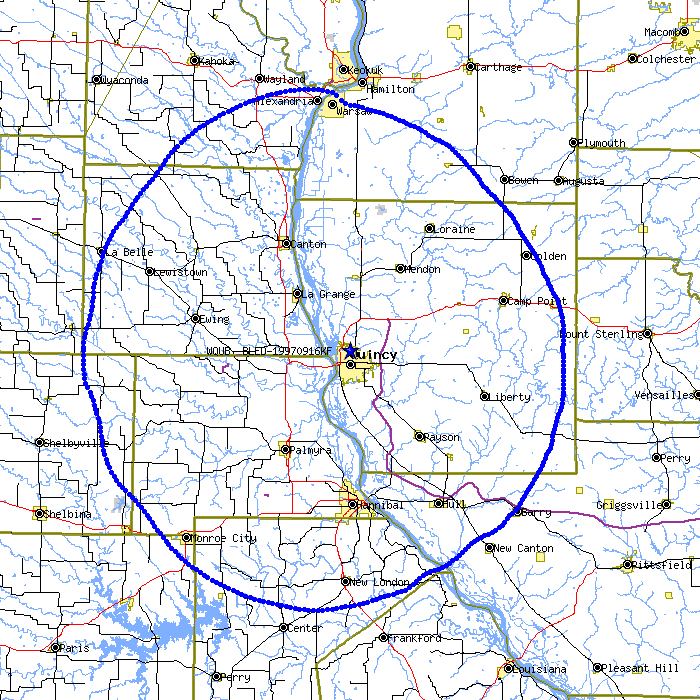
WQUB
Encyclopedia
WQUB is a 28,000-watt radio station
in Quincy, Illinois
, in western Illinois
along the Mississippi River. This station provides primary coverage for nine counties in the western Illinois and northeastern Missouri region. Quincy University
Corporation is the station licensee, authorized by the Federal Communications Commission
.
On Weekends WQUB branches out to include entertainment programs like Car Talk, Whad'Ya Know and A Prairie Home Companion as well as locally produced jazz and blues shows.

Radio station
Radio broadcasting is a one-way wireless transmission over radio waves intended to reach a wide audience. Stations can be linked in radio networks to broadcast a common radio format, either in broadcast syndication or simulcast or both...
in Quincy, Illinois
Quincy, Illinois
Quincy, known as Illinois' "Gem City," is a river city along the Mississippi River and the county seat of Adams County. As of the 2010 census the city held a population of 40,633. The city anchors its own micropolitan area and is the economic and regional hub of West-central Illinois, catering a...
, in western Illinois
Illinois
Illinois is the fifth-most populous state of the United States of America, and is often noted for being a microcosm of the entire country. With Chicago in the northeast, small industrial cities and great agricultural productivity in central and northern Illinois, and natural resources like coal,...
along the Mississippi River. This station provides primary coverage for nine counties in the western Illinois and northeastern Missouri region. Quincy University
Quincy University
Quincy University a private liberal arts Catholic university in the Franciscan tradition. It is located in Quincy, Illinois and currently enrolls around 1,300 students.-History:...
Corporation is the station licensee, authorized by the Federal Communications Commission
Federal Communications Commission
The Federal Communications Commission is an independent agency of the United States government, created, Congressional statute , and with the majority of its commissioners appointed by the current President. The FCC works towards six goals in the areas of broadband, competition, the spectrum, the...
.
Format
The format includes classical music, alternative rock, jazz and in-depth news and information. WQUB is a full member of National Public Radio and an affiliate of Public Radio International. Our broadcast day begins with Morning Edition and concludes with alternative rock shows programmed and hosted by students of Quincy University. In between, we offer local classical music programs like Intermezzo and national shows like Performance Today and the Saint Louis Symphony concert series. We also provide the in-depth news of All Things Considered and cultural interviews on Fresh Air. As of 2005, WQUB airs broadcasts from the World Radio Network when it would otherwise be 'off the air.'On Weekends WQUB branches out to include entertainment programs like Car Talk, Whad'Ya Know and A Prairie Home Companion as well as locally produced jazz and blues shows.

History
- 1948 – A carrier currentCarrier currentCarrier current is a method of low power AM radio transmission that uses the AC electrical system of a building to propagate a medium frequency, AM signal to a relatively small area, such as a building or a group of buildings...
(AM) radio station begins at Quincy College.
- April 1974 – WWQC is born as a Low powerLow-power broadcastingLow-power broadcasting is electronic broadcasting at very low power and low cost, to a small community area.The terms "low-power broadcasting" and "micropower broadcasting" should not be used interchangeably, because the markets are not the same...
FM station with 10 watts (old class D) at 90.3 FM.
- 1983 - The station transmitting power was increased to 100 watts to cover the college grounds and surrounding neighborhoods. The resulting feedback from students, faculty and community was quite positive and encouraged the school to make a commitment to providing the Quincy-Hannibal area with quality public radio programming.
- 1988 – The station begins its association with National Public Radio. Thanks to the help of the Marion Gardner Jackson Charitable Trust, Harris Corporation and Broadcast Electronics as well as volunteers like Ted Wahlman and Wally Kabrick, the station facility was improved and the power raised to 10,000 watts. During this time, the call letters were changed from WWQC-FM to WQUB-FM, reflecting the school's name change from Quincy College to Quincy University.
- 2000 – Transmitter power increased to 28,000 watts, expanding coverage to present nine-county region.

